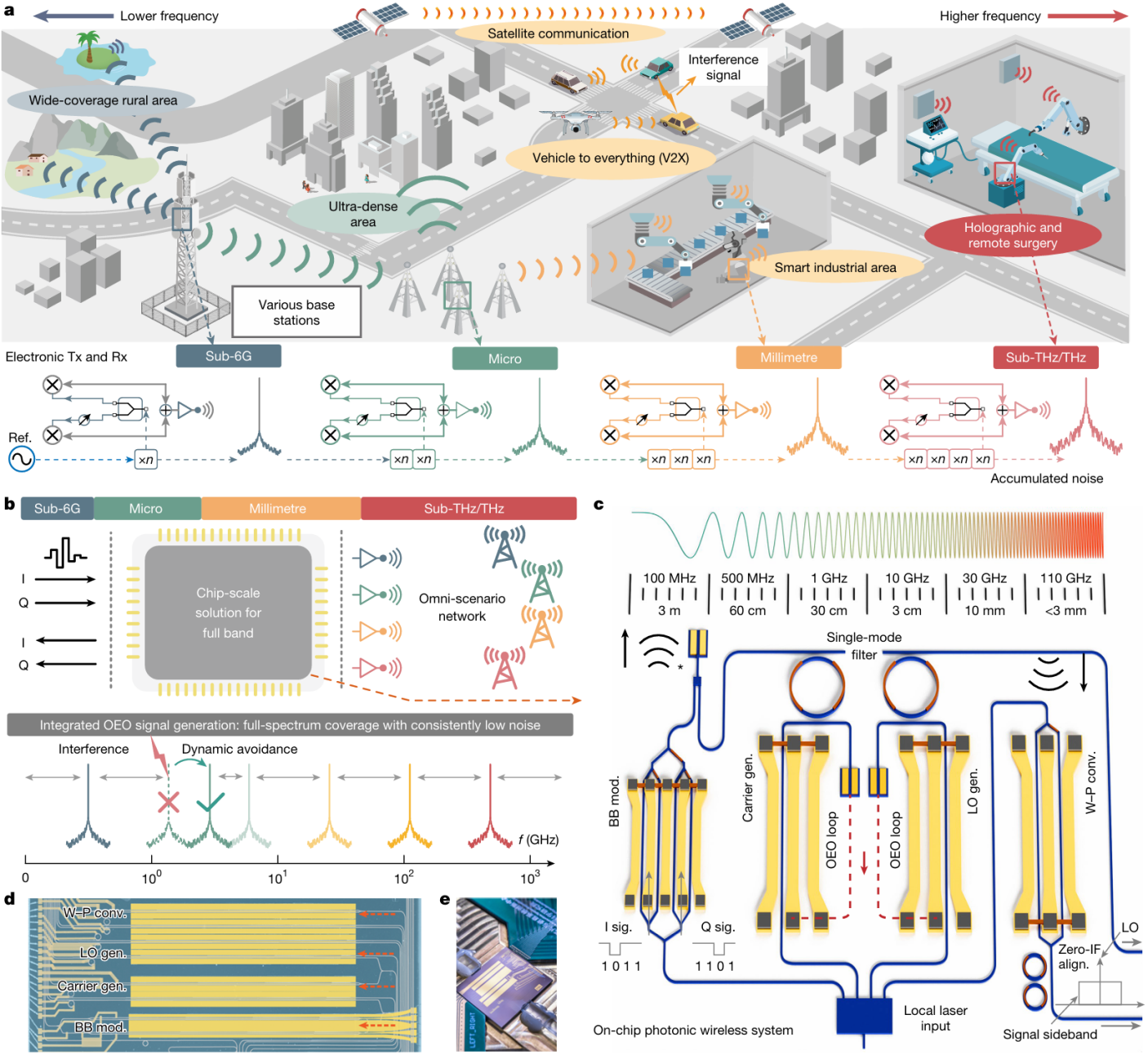Youth Student Basic Research Project PI achieves breakthrough in optoelectronic chips for wireless communications

Supported by the National Natural Science Foundation of China (NSFC) under the Youth Student Basic Research Project (Grant No. 623B2004), the Key Program (Grant No. 62235002), the Major Program of Development of Scientific Instruments (Grant No. 62327811), and the Class B and Class C Young Scientists Fund (Grant Nos. 62322501 and 12204021), a research team led by Ph.D. student Zihan Tao, Professor Xingjun Wang, and Researcher Haowen Shu from Peking University, together with Professor Cheng Wang from City University of Hong Kong, has achieved a major breakthrough in next-generation wireless communications (6G) via integrated optoelectronic technology. For the first time, they have realized adaptive full-spectrum high-speed wireless communication based on an integrated optoelectronic chip. On August 27, 2025, the related research results were published online in the top international academic journal Nature under the title “Ultrabroadband on-chip photonics for full-spectrum wireless communications” (DOI: https://doi.org/10.1038/s41586-025-09451-8). Notably, the paper’s first author, Ph.D. student Zihan Tao, was awarded one of the inaugural NSFC Youth Student Basic Research Projects for his project “Integrated microwave photonic RF front-end chip research for 6G full-spectrum access”, which provided critical support for the development of the work presented in this paper.
To meet the rapidly growing demand for ubiquitous access, future next-generation wireless communication networks will need to dynamically and in real time exploit full-spectrum resources to support diverse application scenarios (Fig. 1a). However, conventional electronic hardware can only operate within a single frequency band, and devices working in different bands rely on distinct design rules, structures, and materials, making it extremely difficult to achieve cross-band or full-spectrum operation. Therefore, a universal hardware solution is urgently needed—one that is compatible with full-band wireless signals while also meeting requirements for miniaturization, lightweight integration, and low-power operation.
The research team proposed the concept of a “universal optoelectronic wireless engine.” Based on an advanced thin-film lithium niobate photonic material platform, they successfully developed an ultrabroadband optoelectronic integrated chip that enables adaptive, reconfigurable, high-speed wireless communication across a coverage range exceeding 110 GHz (Fig. 1b). Within a compact functional footprint of just 11 mm × 1.7 mm (Figs. 1d and 1e), the chip integrates complete wireless signal processing functions—including broadband wireless-to-optical conversion, tunable low-noise carrier/local oscillator generation, and digital baseband modulation—achieving system-levelintegration (Fig. 1c). Compared to traditional electronic solutions based on frequency multipliers, this on-chip OEO (optoelectronic oscillator) system for the first time demonstrates real-time, flexible, and rapid reconfigurability across center frequencies ranging from 0.5 GHz to 115 GHz. Its low-noise signal tuning performance spanning nearly eight octaves marks a milestone breakthrough unattainable by any other platform or technology to date.
This solution fundamentally avoids the problem of severe phase noise degradation at higher frequency bands caused by noise accumulation in conventional frequency multiplier chains. It thereby overcomes the long-standing trade-off among bandwidth, noise performance, and reconfigurability that has constrained prior systems. Experimental validation shows that the system achieves ultrahigh wireless transmission rates exceeding 120 Gbps, meeting the peak data rate requirements of 6G communications. Meanwhile, the demonstration of adaptive high-speed wireless communication is successfully performed across different frequencies within the 100 GHz band. The research results are expected to serve as a technological engine for the revolution of next-generation wireless communications, driving collaborative innovation and leapfrog development across the entire industry ecosystem.
Contact Us

National Natural Science Foundation of China
Add: 83 Shuangqing Rd., Haidian District, Beijing, China
Postcode: 100085
Tel: 86-10-62327001
Fax: 86-10-62327004
E-mail: bic@nsfc.gov.cn
